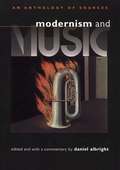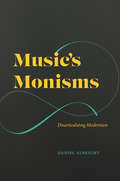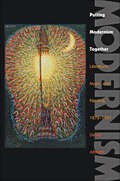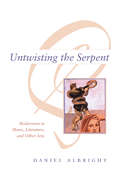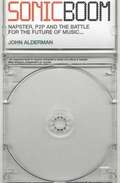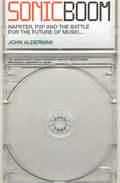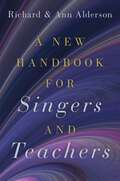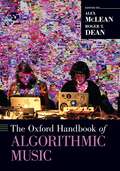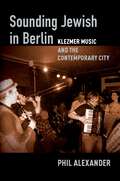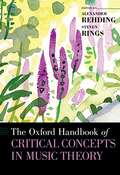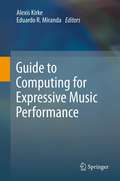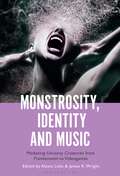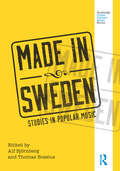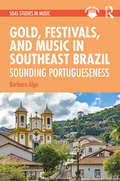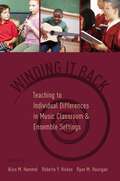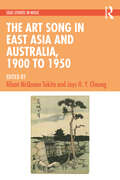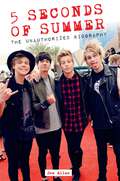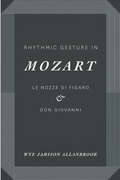- Table View
- List View
Modernism and Music: An Anthology of Sources (Hopkins Studies In Modernism Ser.)
by Daniel AlbrightIf in earlier eras music may have seemed slow to respond to advances in other artistic media, during the modernist age it asserted itself in the vanguard. Modernism and Music provides a rich selection of texts on this moment, some translated into English for the first time. It offers not only important statements by composers and critics, but also musical speculations by poets, novelists, philosophers, and others-all of which combine with Daniel Albright's extensive, interlinked commentary to place modernist music in the full context of intellectual and cultural history.
Music's Monisms: Disarticulating Modernism
by Daniel AlbrightDaniel Albright investigates musical phenomena through the lens of monism, the philosophical belief that things that appear to be two are actually one. Daniel Albright was one of the preeminent scholars of musical and literary modernism, leaving behind a rich body of work before his untimely passing. In Music’s Monisms, he shows how musical and literary phenomena alike can be fruitfully investigated through the lens of monism, a philosophical conviction that does away with the binary structures we use to make sense of reality. Albright shows that despite music’s many binaries—diatonic vs. chromatic, major vs. minor, tonal vs. atonal—there is always a larger system at work that aims to reconcile tension and resolve conflict. Albright identifies a “radical monism” in the work of modernist poets such as T. S. Eliot and musical works by Wagner, Debussy, Britten, Schoenberg, and Stravinsky. Radical monism insists on the interchangeability, even the sameness, of the basic dichotomies that govern our thinking and modes of organizing the universe. Through a series of close readings of musical and literary works, Albright advances powerful philosophical arguments that not only shed light on these specific figures but also on aesthetic experience in general. Music’s Monisms is a revelatory work by one of modernist studies’ most distinguished figures.
Putting Modernism Together: Literature, Music, and Painting, 1872–1927 (Hopkins Studies in Modernism)
by Daniel AlbrightHow do you rationally connect the diverse literature, music, and painting of an age? Throughout the modernist era�which began roughly in 1872 with the Franco-Prussian War, climaxed with the Great War, and ended with a third catastrophe, the Great Depression�there was a special belligerence to this question. It was a cultural period that envisioned many different models of itself: to the Cubists, it looked like a vast jigsaw puzzle; to the Expressionists, it resembled a convulsive body; to the Dadaists, it brought to mind a heap of junk following an explosion. In Putting Modernism Together, Daniel Albright searches for the center of the modernist movement by assessing these various artistic models, exploring how they generated a stunning range of creative work that was nonetheless wound together aesthetically, and sorting out the cultural assumptions that made each philosophical system attractive. Emerging from Albright's lectures for a popular Harvard University course of the same name, the book investigates different methodologies for comparing the evolution and congruence of artistic movements by studying simultaneous developments that occurred during particularly key modernist years. What does it mean, Albright asks, that Joseph Conrad's Heart of Darkness, published in 1899, appeared at the same time as Claude Debussy's Nocturnes�beyond the fact that the word "Impressionist" has been used to describe each work? Why, in 1912, did the composer Arnold Schoenberg and the painter Vassily Kandinsky feel such striking artistic kinship? And how can we make sense of a movement, fragmented by isms, that looked for value in all sorts of under- or ill-valued places, including evil (Baudelaire), dung heaps (Chekhov), noise (Russolo), obscenity (Lawrence), and triviality (Satie)? Throughout Putting Modernism Together, Albright argues that human culture can best be understood as a growth-pattern or ramifying of artistic, intellectual, and political action. Going beyond merely explaining how the artists in these genres achieved their peculiar effects, he presents challenging new analyses of telling craft details which help students and scholars come to know more fully this bold age of aesthetic extremism.
Untwisting the Serpent: Modernism in Music, Literature, and Other Arts
by Daniel AlbrightFrom its dissonant musics to its surrealist spectacles (the urinal is a violin!), Modernist art often seems to give more frustration than pleasure to its audience. In Untwisting the Serpent, Daniel Albright shows that this perception arises partly because we usually consider each art form in isolation, even though many of the most important artistic experiments of the Modernists were collaborations involving several media—Igor Stravinsky's The Rite of Spring is a ballet, Gertrude Stein's Four Saints in Three Acts is an opera, and Pablo Picasso turned his cubist paintings into costumes for Parade. Focusing on collaborations with a musical component, Albright views these works as either figures of dissonance that try to retain the distinctness of their various media (e.g. Guillaume Apollinaire's Les Mamelles de Tirésias) or figures of consonance that try to lose themselves in some total effect (e.g. Arnold Schoenberg's Erwartung). In so doing he offers a fresh picture of Modernism, and provides a compelling model for the analysis of all artistic collaborations. Untwisting the Serpent is the recipient of the 2001 Susanne M. Glasscock Humanities Book Prize for Interdisciplinary Scholarship of the Center for Humanities Research at Texas A&M University.
Sonic Boom: Napster, P2P and the Battle for the Future of Music (PDF)
by John AldermanThe first book to tell the inside story of the battle for control over the future of music and how technology is ripping up the traditional rules of business. As the internet grew throughout the 1990s, software was developed, such as Liquid Audio and MP3, that could deliver music anywhere and most importantly for free. Bands were reaching fans without record company support; entrepreneurs made money distributing digital music files without licensing agreements; the music industry executives complained of piracy and refused to embrace the Information Age.
Sonic Boom: Napster, P2p And The Battle For The Future Of Music
by John AldermanThe first book to tell the inside story of the battle for control over the future of music and how technology is ripping up the traditional rules of business.
A New Handbook for Singers and Teachers
by Richard Alderson Ann AldersonThe practices of singing and teaching singing are inextricable, joined to each other through the necessity of understanding the vocal art and craft. Just as singers must understand the physical functions of voice in order to become musically proficient and artistically mature, teachers too need to have a similar mastery of these ideas - and the ability to explain them to their students - in order to effectively guide their musical and artistic growth. With this singer-instructor relationship in mind, Richard and Ann Alderson's A New Handbook for Singers and Teachers presents a fresh, detailed guide about how to sing and how to teach singing. It systematically explores all aspects of the vocal technique - respiration, phonation, resonance, and articulation - with each chapter containing exercises aimed at applying and teaching these principles. Beyond basic vocal anatomy and singing fundamentals, the handbook also covers such understudied topics as the young voice, the changing voice, and the aging voice, along with helpful chapters for teachers about how to organize vocal lessons and training plans. Thoughtfully and comprehensively crafted by two authors with decades of singing and teaching experience between them, A New Handbook for Singers and Teachers will prove an invaluable resource for singers and teachers at all stages of their vocal and pedagogical careers.
NEW HANDBOOK FOR SINGERS & TEACHERS C
by Richard Alderson Ann AldersonThe practices of singing and teaching singing are inextricable, joined to each other through the necessity of understanding the vocal art and craft. Just as singers must understand the physical functions of voice in order to become musically proficient and artistically mature, teachers too need to have a similar mastery of these ideas - and the ability to explain them to their students - in order to effectively guide their musical and artistic growth. With this singer-instructor relationship in mind, Richard and Ann Alderson's A New Handbook for Singers and Teachers presents a fresh, detailed guide about how to sing and how to teach singing. It systematically explores all aspects of the vocal technique - respiration, phonation, resonance, and articulation - with each chapter containing exercises aimed at applying and teaching these principles. Beyond basic vocal anatomy and singing fundamentals, the handbook also covers such understudied topics as the young voice, the changing voice, and the aging voice, along with helpful chapters for teachers about how to organize vocal lessons and training plans. Thoughtfully and comprehensively crafted by two authors with decades of singing and teaching experience between them, A New Handbook for Singers and Teachers will prove an invaluable resource for singers and teachers at all stages of their vocal and pedagogical careers.
Singer-Songwriters and Musical Open Mics
by Marcus AldredgeSinger-Songwriters and Musical Open Mics is an ethnographic exploration of New York City’s live music events where musicians signup and perform short sets. This sociological study dispels the common assumption that open mics are culturally monolithic and reserved for novice musicians. Open mics allow musicians at different locations within their musical development and career to interactively perform, practice, and network with other musicians. Important themes in the book include: the tension between self and society in the creative process, issues of creative authenticity and authorship, and on-going cultural changes central to the Do-It-Yourself cultural zeitgeist of the early 21st century. The open mic’s cultural antecedents include a radio format, folk hootenannies, and the jazz jam session. Drawing from multiple qualitative methods, Aldredge describes how open mics have etched a vital organizational place in the western and urban musical landscape. Open mics represent a creative place where the boundaries of practicing and performing seemingly blur. This allows for a range of social settings from more competitive, stratified, and homogenous music scenes to culturally diverse weekly events often stretching late into the night.
Singer-Songwriters and Musical Open Mics
by Marcus AldredgeSinger-Songwriters and Musical Open Mics is an ethnographic exploration of New York City’s live music events where musicians signup and perform short sets. This sociological study dispels the common assumption that open mics are culturally monolithic and reserved for novice musicians. Open mics allow musicians at different locations within their musical development and career to interactively perform, practice, and network with other musicians. Important themes in the book include: the tension between self and society in the creative process, issues of creative authenticity and authorship, and on-going cultural changes central to the Do-It-Yourself cultural zeitgeist of the early 21st century. The open mic’s cultural antecedents include a radio format, folk hootenannies, and the jazz jam session. Drawing from multiple qualitative methods, Aldredge describes how open mics have etched a vital organizational place in the western and urban musical landscape. Open mics represent a creative place where the boundaries of practicing and performing seemingly blur. This allows for a range of social settings from more competitive, stratified, and homogenous music scenes to culturally diverse weekly events often stretching late into the night.
Health, the Individual, and Integrated Medicine: Revisiting an Aesthetic of Health Care (PDF)
by David AldridgeHow do we decide on the most effective way to heal ourselves or our patients? Complementary therapies are a vital part of any integrated approach to health which incorporates specialist and layperson knowledge. In this book, David Aldridge examines cultural understandings of illness and medicines. He provides a critique of orthodox methods used to assess treatment, and advocates a more pluralistic approach to medical research and practice, encompassing the physical, psychological, spiritual and social dimensions of a person's life. To assess medical research in a range of situations, Aldridge examines how asthma can be treated by acupuncture, how communities cope with terminal cancer and how music therapy and spiritual healing can be used. In a positive move to improve current healthcare systems, Aldridge suggests guidelines for medical education and research. Doctors and other healthcare professionals, academics, students and people undergoing treatment themselves will be inspired by this direct, thoughtful and practical guide to research in current healthcare practice. David Aldridge is the author of a number of books within related fields such as Spirituality, Healing and Medicine: Return to the Silence and Music Therapy Research and Practice in Medicine, both published by Jessica Kingsley Publishers.
Melody in Music Therapy: A Therapeutic Narrative Analysis (PDF)
by David Aldridge Gudrun AldridgeMelody is thought to be an 'essential core' of music. In the context of music therapy, looking at how patients develop their own melodies in improvisation can explain how they find their own voice, determine their position in relation to the world, and play an important role in how they relate to their therapist. Gudrun Aldridge and David Aldridge explore the concept of melody within its historical context and investigate current theories of melody. They make recommendations for choosing an appropriate method of analysing melodic improvisation, and utilise case studies to demonstrate these analyses in practice. They show how the interaction between patient and therapist is affected by the patient's melodic statements, and how the process of improvisation offers patients a chance to transform their inner emotions into externalised expressions. Melody in Music Therapy is an important addition to music therapy literature, and will be of interest to music therapists, educators and students alike, as well as musicologists.
The Oxford Handbook of Algorithmic Music (Oxford Handbooks)
by Alex Mclean and Roger T. DeanWith the ongoing development of algorithmic composition programs and communities of practice expanding, algorithmic music faces a turning point. Joining dozens of emerging and established scholars alongside leading practitioners in the field, chapters in this Handbook both describe the state of algorithmic composition and also set the agenda for critical research on and analysis of algorithmic music. Organized into four sections, chapters explore the music's history, utility, community, politics, and potential for mass consumption. Contributors address such issues as the role of algorithms as co-performers, live coding practices, and discussions of the algorithmic culture as it currently exists and what it can potentially contribute society, education, and ecommerce. Chapters engage particularly with post-human perspectives - what new musics are now being found through algorithmic means which humans could not otherwise have made - and, in reciprocation, how algorithmic music is being assimilated back into human culture and what meanings it subsequently takes. Blending technical, artistic, cultural, and scientific viewpoints, this Handbook positions algorithmic music making as an essentially human activity.
Sounding Jewish in Berlin: Klezmer Music and the Contemporary City
by Phil AlexanderHow can a traditional music with little apparent historical connection to Berlin become a way of hearing and making sense of the bustling German capital in the twenty-first century? In Sounding Jewish in Berlin, author Phil Alexander explores the dialogue between the city's contemporary klezmer scene and the street-level creativity that has become a hallmark of Berlin's decidedly modern urbanity and cosmopolitanism. By tracing how klezmer music engages with the spaces and symbolic meanings of the city, Alexander sheds light on how this Eastern European Jewish folk music has become not just a product but also a producer of Berlin. This engaging study of Berlin's dynamic Yiddish music scene brings together ethnomusicology, cultural studies, and urban geography to evoke the sounds, atmospheres, and performance spaces through which klezmer musicians have built a lively set of musical networks in the city. Transcending a restrictive framework that considers this music solely in the context of troubled German-Jewish history and notions of guilt and absence, Alexander shows how Berlin's current klezmer communitya diverse group of Jewish and non-Jewish performersimaginatively blend the genre's traditional musical language with characteristically local tones to forge an adaptable and distinctively twenty-first-century version of klezmer. Ultimately, the music's vital presence in Berlin is powerful evidence that if traditional music is to remain audible amid the noise of the urban, it must become a meaningful part of that noise.
Sounding Jewish in Berlin: Klezmer Music and the Contemporary City
by Phil AlexanderHow can a traditional music with little apparent historical connection to Berlin become a way of hearing and making sense of the bustling German capital in the twenty-first century? In Sounding Jewish in Berlin, author Phil Alexander explores the dialogue between the city's contemporary klezmer scene and the street-level creativity that has become a hallmark of Berlin's decidedly modern urbanity and cosmopolitanism. By tracing how klezmer music engages with the spaces and symbolic meanings of the city, Alexander sheds light on how this Eastern European Jewish folk music has become not just a product but also a producer of Berlin. This engaging study of Berlin's dynamic Yiddish music scene brings together ethnomusicology, cultural studies, and urban geography to evoke the sounds, atmospheres, and performance spaces through which klezmer musicians have built a lively set of musical networks in the city. Transcending a restrictive framework that considers this music solely in the context of troubled German-Jewish history and notions of guilt and absence, Alexander shows how Berlin's current klezmer communitya diverse group of Jewish and non-Jewish performersimaginatively blend the genre's traditional musical language with characteristically local tones to forge an adaptable and distinctively twenty-first-century version of klezmer. Ultimately, the music's vital presence in Berlin is powerful evidence that if traditional music is to remain audible amid the noise of the urban, it must become a meaningful part of that noise.
The Oxford Handbook of Critical Concepts in Music Theory (Oxford Handbooks)
by Alexander Rehding and Steven RingsMusic Theory has a lot of ground to cover. Especially in introductory classes a whole range of fundamental concepts are introduced at fast pace that can never be explored in depth or detail, as other new topics become more pressing. The short time we spend with them in the classroom belies the complexity (and, in many cases, the contradictions) underlying these concepts. This book takes the time to tarry over these complexities, probe the philosophical assumptions on which these concepts rest, and shine a light on all their iridescent facets. This book presents music-theoretical concepts as a register of key terms progressing outwards from smallest detail to discussions of the music-theoretical project on the largest scale. The approaches individual authors take range from philosophical, historical, or analytical to systematic, cognitive, and critical-theorical-covering the whole diverse spectrum of contemporary music theory. In some cases authors explore concepts that have not yet been widely added to the theorist's toolkit but deserve to be included; in other cases concepts are expanded beyond their core repertory of application. This collection does not shy away from controversy. Taken in their entirety, the essays underline that music theory is on the move, exploring new questions, new repertories, and new approaches. This collection is an invitation to take stock of music theory in the early twenty-first century, to look back and to encourage discussion about its future directions. Its chapters open up a panoramic view of the contemporary music-theoretical landscape with its expanding repertories and changing guiding questions, and offers suggestions as to where music theory is headed in years to come.
Guide to Computing for Expressive Music Performance
by Alexis Kirke and Eduardo R. MirandaThis book discusses all aspects of computing for expressive performance, from the history of CSEMPs to the very latest research, in addition to discussing the fundamental ideas, and key issues and directions for future research. Topics and features: includes review questions at the end of each chapter; presents a survey of systems for real-time interactive control of automatic expressive music performance, including simulated conducting systems; examines two systems in detail, YQX and IMAP, each providing an example of a very different approach; introduces techniques for synthesizing expressive non-piano performances; addresses the challenges found in polyphonic music expression, from a statistical modelling point of view; discusses the automated analysis of musical structure, and the evaluation of CSEMPs; describes the emerging field of embodied expressive musical performance, devoted to building robots that can expressively perform music with traditional instruments.
Monstrosity, Identity and Music: Mediating Uncanny Creatures from Frankenstein to Videogames
by Alexis Luko and James K. WrightTaking Mary Shelley's novel as its point of departure, this collection of essays considers how her creation has not only survived but thrived over 200 years of media history, in music, film, literature, visual art and other cultural forms. In studying monstrous figures torn from the deepest and darkest imaginings of the human psyche, the essays in this book deploy the latest analytical approaches, drawn from such fields as musicology, critical race studies, feminist studies, queer theory and psychoanalysis. The book interweaves the manifold sounds, sights and stories of monstrosity into a conversation that sheds light on important social issues, aesthetic trends and cultural concerns that are as alive today as they were when Shelley's landmark novel was published 200 years ago.
Made in Sweden: Studies in Popular Music (Routledge Global Popular Music Series)
by Alf Björnberg and Thomas BossiusMade in Sweden: Studies in Popular Music serves as a comprehensive and rigorous introduction to the history, sociology and musicology of twentieth-century Swedish popular music. The volume consists of essays by leading scholars of Swedish popular music and covers the major figures, styles and social contexts of pop music in Swedish. Although the vast majority of the contributors are Swedish, the essays are expressly written for an international English-speaking audience. No knowledge of Swedish music or culture will be assumed. Each essay provides adequate context so readers understand why the figure or genre under discussion is of lasting significance to Swedish popular music; each section features a brief introduction by the volume editors. The book presents a general description of the history and background of Swedish popular music, followed by essays that are organized into thematic sections: The Historical Development of the Swedish Popular-Music Mainstream; The Swedishness of Swedish Popular-Music Genres; Professionalization and Diversification; and Swedish Artist Personas. Contributors: Jonas BjälesjöAlf BjörnbergThomas BossiusPeter DahlénOlle EdströmKarin L. ErikssonRasmus FleischerSverker Hyltén-CavalliusLars LilliestamUlf LindbergMorten MichelsenSusanna NordströmMarita RhedinHenrik Smith-SivertsenAnn WernerKajsa Widegren
Gold, Festivals, and Music in Southeast Brazil: Sounding Portugueseness (SOAS Studies in Music)
by Barbara AlgeGold, Festivals, and Music in Southeast Brazil: Sounding Portugueseness is a study of the musical legacy of the eighteenth century Brazilian gold rush that integrates ethnographic research of the main genres of former mining communities in Brazil – from liturgical music in the style of European art music to Afro-Brazilian musical expressions. Its content and structure are informed by Norbert Elias’s idea of the civilizing process, which is explored regarding its relevance in interpreting sociocultural processes and choreo-musical expressions in the small town of Morro Vermelho. The book’s innovative feature is its focus on a little-known area to non-Brazilian scholars, and its focus on the colonial and European heritage in Brazil. Morro Vermelho’s cultural traditions have received relatively limited attention. The Catholic festival of Our Lady of Nazareth provides a setting for the documentation and analysis of the musical setting and is thus placed at the center of the discussion. It leads through the vast writings on Brazilian identity and challenges the view on Brazilian-ness as constructed in terms of the mixing of races. Norbert Elias’s concept of the "civilizing process" structures the book and is relevant for understanding the cultural sphere of the festival of Our Lady of Nazareth. The book combines discourses of Portugueseness with historical sources and observations from fieldwork and community building in the virtual world. The focus on the music to support social constructions of "Portugueseness" is supported with evidence from diverse data sources: music (literature and fieldwork recordings), original interviews, marketing materials and historical narratives. The combination of archival, ethnographic, and bibliographic research methods attempts a seamless narrative. Its approach to fieldwork and frank reflections on the process and relevant issues help to contextualize the analyses and serve as useful advice for future researchers.
Gold, Festivals, and Music in Southeast Brazil: Sounding Portugueseness (SOAS Studies in Music)
by Barbara AlgeGold, Festivals, and Music in Southeast Brazil: Sounding Portugueseness is a study of the musical legacy of the eighteenth century Brazilian gold rush that integrates ethnographic research of the main genres of former mining communities in Brazil – from liturgical music in the style of European art music to Afro-Brazilian musical expressions. Its content and structure are informed by Norbert Elias’s idea of the civilizing process, which is explored regarding its relevance in interpreting sociocultural processes and choreo-musical expressions in the small town of Morro Vermelho. The book’s innovative feature is its focus on a little-known area to non-Brazilian scholars, and its focus on the colonial and European heritage in Brazil. Morro Vermelho’s cultural traditions have received relatively limited attention. The Catholic festival of Our Lady of Nazareth provides a setting for the documentation and analysis of the musical setting and is thus placed at the center of the discussion. It leads through the vast writings on Brazilian identity and challenges the view on Brazilian-ness as constructed in terms of the mixing of races. Norbert Elias’s concept of the "civilizing process" structures the book and is relevant for understanding the cultural sphere of the festival of Our Lady of Nazareth. The book combines discourses of Portugueseness with historical sources and observations from fieldwork and community building in the virtual world. The focus on the music to support social constructions of "Portugueseness" is supported with evidence from diverse data sources: music (literature and fieldwork recordings), original interviews, marketing materials and historical narratives. The combination of archival, ethnographic, and bibliographic research methods attempts a seamless narrative. Its approach to fieldwork and frank reflections on the process and relevant issues help to contextualize the analyses and serve as useful advice for future researchers.
Winding It Back: Teaching to Individual Differences in Music Classroom and Ensemble Settings
by Alice M. Hammel, Roberta Y. Hickox, and Ryan M. HouriganWinding it Back: Teaching to Individual Differences in Music Classroom and Ensemble Settings is a collaborative effort written by practicing music educators, teacher educators, pedagogy experts, researchers, and inclusion enthusiasts with a combined one hundred plus years in the field of music education. The framework of this text is centered on three core principles: Honoring the individual learning needs of all students; providing multiple access points and learning levels; and providing adequate learning conditions for all students within the music classroom. Topics include early childhood music, creative movement, older beginners, rhythm, and tonal development as well as secondary choral and instrumental music. All chapters focus on meeting the needs of all students and all learning levels within the music classroom. This book is ideal for practicing music educators, teacher educators, and arts integration specialists and enthusiasts alike. It provides specific musical examples both within the text and on the extended companion website including musical examples, lesson ideas, videos, assessment tools and sequencing ideas that work. The aim of this book is to provide one resource that can be used by music educators for all students in the music classroom both for classroom music education and music teacher preparation. Visit the companion website at www.oup.com/us/windingitback
The Art Song in East Asia and Australia, 1900 to 1950 (SOAS Studies in Music)
by Alison McQueen Tokita and Joys H. Y. CheungThis book explores art song as an emblem of musical modernity in early twentieth-century East Asia and Australia. It appraises the lyrical power of art song – a solo song set to a poem in the local language in Western art music style accompanied by piano – as a vehicle for creating a localized musical identity, while embracing cosmopolitan visions. The study of art song reveals both the tension and the intimacy between cosmopolitanism and local politics and culture. In 20 essays, the book includes overviews of art song development written by scholars from each of the five locales of Japan, Korea, China, Taiwan, and Australia, reflecting perspectives of both established narratives and uncharted historiography. The Art Song in East Asia and Australia, 1900 to 1950 proposes listening to the songs of our neighbours across cultural and linguistic boundaries. Recognizing the colonial constraints experienced by art song composers, it hears trans-colonial expressions addressing musical modernity, both in earlier times and now. Readers of this volume will include musicologists, ethnomusicologists, singers, musicians, and researchers concerned with modernity in the fields of poetry and history, working within local, regional, and transnational contexts.
5 Seconds of Summer: The Unauthorized Biography
by Joe AllanThe biography of the hottest new Australian band taking the pop world by storm. Luke, Michael, Calum and Ashton have become an overnight sensation, topping the charts in fifty-one countries and selling out their first US solo tour in just five minutes.From their humble beginnings posting videos of their songs on YouTube to supporting One Direction on tour and releasing their first album, the past year has been a roller-coaster journey for the boys. 5 Seconds of Summer: The Unauthorized Biography explores the early lives and backgrounds of the boys, their determination to gain recognition, touring with One Direction and coping with sudden international fame.This is the story of four talented, fun and down-to-earth boys who refuse to be known as just another boy band, and is a must-have for any 5SOS fan.
Rhythmic Gesture in Mozart: Le Nozze di Figaro and Don Giovanni
by Wye Jamison AllanbrookWye Jamison Allanbrook’s widely influential Rhythmic Gesture in Mozart challenges the view that Wolfgang Amadeus Mozart’s music was a “pure play” of key and theme, more abstract than that of his predecessors. Allanbrook’s innovative work shows that Mozart used a vocabulary of symbolic gestures and musical rhythms to reveal the nature of his characters and their interrelations. The dance rhythms and meters that pervade his operas conveyed very specific meanings to the audiences of the day.
